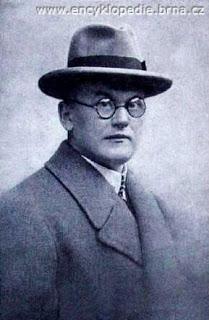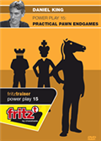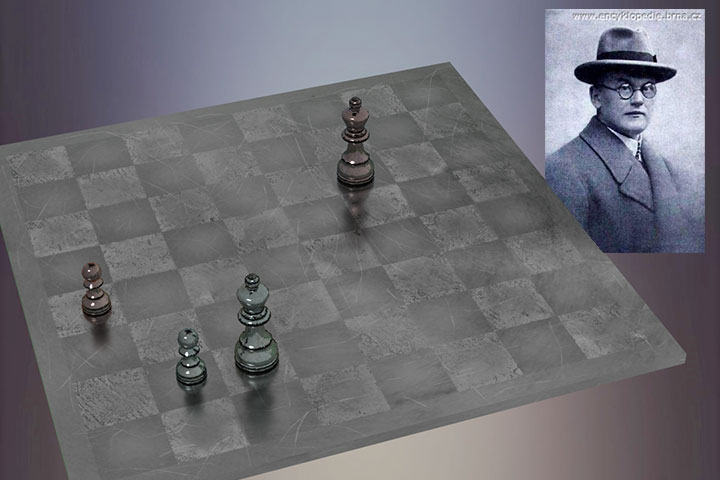Study of the Month: January 2020
Today’s protagonist technically was a Czech/Czechoslovakian, he is usually referred to as a Moravian or Bohemian, so the label of that subseries might be too broad.
As always, feel free to skip to the end and enjoy replaying the studies, if that's your preference.
While he might not be the most well-known composer, you might have seen the name “Dedrle” above a diagram or two in some endgame book, most likely the following one.
This position is often attributed to Frantisek Dedrle, who, however, in quoting it in 1921 did not claim authorship. Its origin is obscure, a certain Dr Cassidy having demonstrated the win by Kb1 in 1884 and B. Horwitz having composed a study using the idea.
(A. J. Roycroft: “The Chess Endgame Study: A Comprehensive Introduction, Second Edition” [first version known as “Test Tube Chess”], Dover 1981, reprint 2016)
The source given in endgame study database hhdbv (giving Dedrle as author of this version of Cassidy’s study in “Kalendar Ceskych Sachistu 1918”) is unsatisfactory, seeing that Roycroft quotes Tattersall’s “A Thousand End-Games” from 1910 where the position above appeared as no.31. Is the above confusion possibly resolvable by one of our readers?
About František Dedrle
 (13 October 1878 — 28 May 1957) was the younger brother of the problem composer Cyril Dedrle (5 July 1876 — 24 January 1944), whose short biography and problem selection is available in a booklet by Ing. Ilja Mikan in the series “Gallery of Ceskoslovensky Chess Composers” (I. Mikan: “Galerie Československých Skladatelú, svazek 11: Cyril Dedrle”, Prague 1974) where “svazek” means “number” or ”issue”. In that source, Ilja Mikan misspells the birth year of F. Dedrle as 1876, which would have been only almost physically impossible for their mother as it would have been one of the few cases of a rare double pregnancy. However, none of this is of practical relevance in our case, as other sources clearly state the birth date of František Dedrle as given above, i.e. in 1878, thus leaving no room for the improbable.
(13 October 1878 — 28 May 1957) was the younger brother of the problem composer Cyril Dedrle (5 July 1876 — 24 January 1944), whose short biography and problem selection is available in a booklet by Ing. Ilja Mikan in the series “Gallery of Ceskoslovensky Chess Composers” (I. Mikan: “Galerie Československých Skladatelú, svazek 11: Cyril Dedrle”, Prague 1974) where “svazek” means “number” or ”issue”. In that source, Ilja Mikan misspells the birth year of F. Dedrle as 1876, which would have been only almost physically impossible for their mother as it would have been one of the few cases of a rare double pregnancy. However, none of this is of practical relevance in our case, as other sources clearly state the birth date of František Dedrle as given above, i.e. in 1878, thus leaving no room for the improbable.
There is unfortunately not much information available on František Dedrle, so we can only repeat what is readily available for example in the Mala encyklopedie sachu. Dedrle authored the following books (unless noted otherwise): Theorie vzájemně blokovaného pěšce (1919, article), Böhmische Schachminiaturen (1922), Studie (1925), Echo (1927), Finales artisticos (1947), Moderni koncovka (1950). Prior to and during that time he worked as problem editor for the Časopis českých šachistů (1913-1922, since 1920 as Časopis československých šachistů) and study editor in the same magazine (1927-1934, as Československý šach). According to the article by John Beasley in “British Endgame Study News”, special number 31, June 2002, the 1950 book was supposed to be the first of a five volume encyclopedia, but the others never were finished.
If you look for the 1919 article online, you will not find it mentioned by name, but you can find an excerpt from Beasley’s article, referring to it as “an article on Drtina's theory of critical squares in pawn endings”. The German language refers to the critical squares as “Gegenfelder”, but a translation as “anti fields” or “opposing fields” could be misleading. The term “critical squares” in this context refers to squares of (usually mutual) zugzwang. While studies with that theme can be of extraordinary depth that can be worked out mathematically, only the most basic forms of them are relevant to study in practice, such as when and how the endgame of king and pawn versus king is won. The first replayable study (below) appears in Beasley’s article and demonstrates that theme. You can find the important setup of it — after its first move — also at the addendum after this article for a small introduction to the theory of “opposing” squares, explaining how the solution can be found.
František Dedrle researched systematically the pawnless endgames of queen against two bishops (Šach 1939-1940) and queen against two knights (Šach 1943-1944) as well as queen and Pg5/e5 against rook and Pf7, showing when a fortress exists there, and when not (28 Rijen 1925; thanks to the move Ra6 a queen sacrifice into a won pawn endgame sometimes can be avoided), and queen against rook and advanced pawn (Národní osvobození 1937-1938). As a small interesting fact, the title “28 Rijen”, translating to “28 October” was chosen by its publisher for the newspaper because of the 28 October 1918 political events leading to the independence of Czechoslovakia (by the declaration ten days prior), leading to the end of the Kingdom of Bohemia. It would however be beyond the scope of this article to detail all political events. The only one necessary to cover is that to my knowledge both Dedrle brothers were not direct victims of any political circumstances, i.e. repression or war combat.
Cyril Dedrle mostly composed checkmates in three moves. His account, as translated by a Slovakian friend who isn’t a chess player, in the book was apparently written with information provided by Zdenek Dedrle, the son of Cyril Dedrle. Both Cyril and František were born in Tišnov, one of the Moravian chess centers that also saw Ladislav Vetešník, Antonín Zeman and Vladimir Kos as its visitors.
Tišnov is a town in the South Moravian Region, 22 km northwest of Brno — two local attractions are a cave with a nature reserve and a 13th century convent with a museum
The father of the Dedrle brothers was farmer František Dedrle from Předklášteří. We will call him František Dedrle senior to avoid confusion. Contrasting his hard physical labor, his children František and Anna chose teaching as their profession. There is no information about the other daughter Maria. Cyril worked in the electrical profession until retirement when he lived together with his daughter (multi-generation homes with entire families were normal back then).
The both brothers learned chess as children, and while Cyril at first only solved problems, František interested him in composing indirectly by composing endgame studies. Cyril at the time was relatively old for a new composer, but thanks to this his problems were of great quality. There is an inconsistency in the book, saying he was 44 in 1930 when he started composing. Likely 1920 is meant instead, as there are Cyril’s chess problems from May 1920 in the databases. (František’s first endgame studies were published one each in 1916, 1917, and four in 1919.)
Cyril Dedrle initially used a style that Dr. Palkoska liked, but changed it to a style more in accordance with how Miroslav Havel composed, to whom František had contact while his brother Cyril never did; he instead corresponded with Jan Kuželka and later Dr. Zdeněk Mach, publishing his problems in the “Prager Presse” and “Zlatá Praha” columns by Mach. Mach also had a column in the weekly “Světozor”, and the three columns were known for high-quality problems.
Ilja Mikan believes that the Dedrle brothers who only met when playing chess, as they had no friends in common, were not close friends anymore. I give the translation of the following sentence “as is”, hoping that readers can understand the meaning: “Despite them never publishing anything together sometimes it wasn’t clear whose result it was — not once they both shared the same position.” Does this refer to tournament results, or to composing?
When Zdeněk Mach stopped his column in “Prager Presse”, Cyril Dedrle also ended his composing career. He was 62 at that time. A few years later, he died. As Cyril only had one problem published abroad, collecting all of his problems after his death was easy, although Mikan speculates it is possible more problems exist in lesser known columns such as the “Slovenský východ”. The typical style of Cyril Dedrle could be summed up as the typical 1930s composer style, Mikan says. Cyril Dedrle used precise white attacking material and sticked to that style.
As for František Dedrle, the style usually was very much like practical endgames, oftentimes contributing to endgame theory and in some cases it even conveys basic endgame knowledge, such as in the “La Stratégie” 1936 position below with an idea that every practical player should know.
 Based on his own playing experience, Grandmaster Daniel King reveals what is essential knowledge, saving you time in your studies. In the first section of the DVD he takes you through typical motifs and themes. In the second section he tests your knowledge with typical scenarios from actual games.
Based on his own playing experience, Grandmaster Daniel King reveals what is essential knowledge, saving you time in your studies. In the first section of the DVD he takes you through typical motifs and themes. In the second section he tests your knowledge with typical scenarios from actual games.
Video: 4 hours.
White to move draws only with 1.♔c2 ♚e3 2.♔d1! and holding the opposition.
As such, it was not difficult this time to select studies that should be appealing to practical players. As a small bonus, which I believe is necessary after talking about both brothers, two orthodox problems by Cyril Dedrle are added for solving here, you can replay the solutions below this article. I believe that the first problem can also be solved by beginners, so give it a try before peeking. On purpose I chose problems with few material, which is not indicative of Cyril Dedrle’s style, however.
Many thanks to Eric Huber and Vlaicu Crişan for helping find sources, or confirming that none exist. Their blog often is an invaluable help. Thanks also to Ivan from Slovakia (who isn’t a chess player) for translating the introduction to the Mikan book about Cyril Dedrle.
Click or tap an entry in the list to switch positions
Addendum: A short introduction to “opposing squares”
In this position from Dedrle’s 1928 study, White is to move and draw:
The first move (1.e6 f6) was abridged, and you can find the solution replayable below. The question here is how to solve (or find in a game) which squares correspond to each other, i.e. to which square White must move if Black is on a certain square. At first we must find squares Black never can go to with his king. In this case this is g7 and d6. This gives us a first evaluation, but not yet concrete squares. When Black goes to square x, White needs to go to square y, and the same applies vice versa:
f8/g8/h8 - g6/h6; c7 - c5/d5
We need to check how far it is from the squares protecting d6 and g7 to each other. So from c7 to f8 and from d5 to g6 it is three moves each. This gives us the first series of corresponding squares:
c7 - d5; d8 - e4; e8 - f5; f8 - g6
By necessity, we find two more corresponding squares on the kingside, as g7 needs to be protected always: g8 - h6; h8 - g6
If Black is one square away from c7 and d8, i.e. on c8, White must be one square away from d5 and e4. This gives us the next corresponding square:
c8 - d4
The same reasoning can be applied further. If Black is one square away from c8 and c7, White must be one square away from d4 and d5. So that leaves us with a few possibilities: e4, c4 and c5. Since Black can lose a tempo by moving from b8 to b7 but White can’t on e4, it must be discarded. Furthermore, Black must be prevented from getting to c6. So we get:
b7 - c5; b8 - c4.
Now only a8 is unaccounted for, but here multiple squares would suffice. However, White should stay close to the f-pawn, so the best would be d4 or d5. This gives us the following corresponding squares:
a8 - d4/d5; b8 - c4; b7 - c5; c8 - c4; c7 - d5; d8 - e4; e8 - f5; f8 - g6; g8 - h6; h8 - g6
So as long as Pf6 doesn’t move, White can use those squares to enforce a draw. When you replay the solution, you see how this knowledge is used and how all variations, no matter how strange looking at first, show their purpose.
To reiterate: If you need to find the “opposing” squares in a pawn endgame, you must find the squares where a king wins if he penetrates there. If there are multiple squares, find all. Mathematically establish — for example by counting — the distance in squares to bridge the gap. From here, you can assign the first possible correspondences and establish by “retroactive” appliance from those both squares and the distance where squares are that one king must go to when the other does. While this sounds difficult in theory, I hope the explanation above can give you an understandable example.
You probably know that you can move pieces on our replay boards to analyse and even start an engine to help you. You can maximize the replayer, auto-play, flip the board and even change the piece style in the bar below the board.
At the bottom of the notation window on the right there are buttons for editing (delete, promote, cut lines, unannotate, undo, redo) save, play out the position against Fritz and even embed the ChessBase game viewer on your website or blog. Hovering the mouse over any button will show you its function.
Perfect endgame analysis and a huge increase in engine performance: Get it with the new Endgame Turbo 5! This brings the full 6-piece Syzygy endgame tablebases on a pendrive. Just plug it in a USB socket and you are set!

World Federation for Chess Composition (www.wfcc.ch)
Links


















 (13 October 1878 — 28 May 1957) was the younger brother of the problem composer Cyril Dedrle (5 July 1876 — 24 January 1944), whose short biography and problem selection is available in a booklet by Ing. Ilja Mikan in the series “Gallery of Ceskoslovensky Chess Composers” (I. Mikan: “Galerie Československých Skladatelú, svazek 11: Cyril Dedrle”, Prague 1974) where “svazek” means “number” or ”issue”. In that source, Ilja Mikan misspells the birth year of F. Dedrle as 1876, which would have been only almost physically impossible for their mother as it would have been one of the few cases of a
(13 October 1878 — 28 May 1957) was the younger brother of the problem composer Cyril Dedrle (5 July 1876 — 24 January 1944), whose short biography and problem selection is available in a booklet by Ing. Ilja Mikan in the series “Gallery of Ceskoslovensky Chess Composers” (I. Mikan: “Galerie Československých Skladatelú, svazek 11: Cyril Dedrle”, Prague 1974) where “svazek” means “number” or ”issue”. In that source, Ilja Mikan misspells the birth year of F. Dedrle as 1876, which would have been only almost physically impossible for their mother as it would have been one of the few cases of a 





